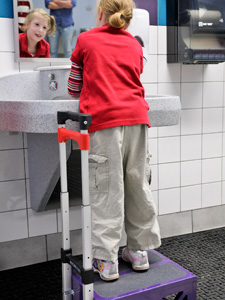By Cindy Carroll
Student engineers build assistive devices for children
Making things better is what engineering is all about.
First year engineering students at the University of Tennessee at Chattanooga build assistive devices for children to improve their daily routines in school and at home. The students work with Signal Centers, a community based nonprofit with a mission focused on assisting with disabilities, childhood education and self-sufficiency. The students also fulfill requests from other organizations and individuals.
Since 2005, these projects have been supported by a grant from the Tennessee Department of Education. Due to budget cuts, the College of Engineering and Computer Science will have to search for new funding — including private donations — for future projects.
Take a look at the achievements of the freshman engineering class in spring 2012:
Playhouse Fun
Two preschoolers at Griffith Elementary School in Dunlap, Tenn., are enjoying free time on the playground in a way they never could before. Koltin’s and J.J.’s wheelchairs can access a new playhouse built to encourage all students to roll in or walk in and use their imagination.
“The children pretend the playhouse is a chicken store, a race car and a music room,” says their teacher, Eileen Carter. “Until now, Koltin and J.J. were more spectators at play time. Now the playhouse is a fun place for everyone to gather.”
Toys inside the structure — steering wheels, a sand wheel and drums — are mounted at different levels so that most are wheelchair accessible. The playhouse also serves as a garage to store riding toys when it rains.
New Level
Playing a game at the coffee table or enjoying a meal with his family at the kitchen table was a challenge for 3-year-old Grant. Now he’s got a secure chair a parent can raise or lower with one hand, thanks to four gas springs and gas shocks.
“He has been confined to one area. We would either have to move a table or use other pieces of equipment to accommodate Grant,” explains his dad, Keith. “The new chair will allow him to sit at any table. It makes everything a whole lot easier.”
Keith believes the engineering students who worked on Grant’s chair deserved their good grades for the project. “For them, the most important thing was to help my child. They wanted the chair to look good, too. They asked if he likes racing stripes,” Keith says, smiling.
Seat Adjustment
Sometimes a student project is a work in progress. For instance, the high chair created by UTC students in 2011 for 3-year-old R.J. needed a few adjustments, so a 2012 group of student engineers made changes.
The new design allows R.J. to use the chair at various heights, and there’s a bonus feature: The chair can swivel 360 degrees. These new changes allow R.J. more social interaction with his parents and other children in his home.
R.J.’s mom, Heather, says the students did an “amazing job that allows R.J. to be more independent. The students were attentive to his needs.”
A Step Up
 If you see Serinity walking around the halls of East Ridge Elementary School, you might wonder about the box she is pulling behind her. It is actually a portable toilet stool, a secure step-up for the tiny 5-year-old.
If you see Serinity walking around the halls of East Ridge Elementary School, you might wonder about the box she is pulling behind her. It is actually a portable toilet stool, a secure step-up for the tiny 5-year-old.
Though the original design called for the device to be carried on Serinity’s back, UTC student Connor Johnson was concerned there was too great a risk for the child to contract a bacterial infection. He suggested a design to look like a rolling suitcase, featuring a collapsible handle. The handle also serves as a railing, providing extra stability for Serinity.
“The UTC students did a really good job customizing this device. Serinity is a princess, and the purple color scheme is really appealing to her so that she wants to use it,” says Shonda Caines, special education preschool teacher at East Ridge Elementary.
Wheel Washer
Twelve-year-old Brendon is like most boys. He enjoys a romp in the backyard with his dog and his brother. And, like most boys, he tracks dirt into the house — dirt on the wheels of his electric wheelchair.
Brendon’s brother, Ryan, a mechanical engineering student at UTC, sought the help of his fellow engineering students, who explain in their summary report: “When there is nobody to clean the wheels, Brendon is prevented from going outside.”
With a few more tweaks to the device, Brendon will soon be able to roll his wheelchair onto the ramp. That action will depress a valve, which will shoot water from a hose to wet the wheels. Then he can roll through the stiff blue brushes and remove the loosened dirt.
– – –
The students who participated in these projects were: Drew Austell, Jordan Butler, Ethan Buyer, Daniel Deslattes, Andrew Donahoo, Matthew Faircloth, Darrius Gray, Marshall Guillot, David Harris, Wes Hutchins, Connor Johnson, River Kaines, David Kibe, Daniel Lawrence, Tom Mammen, Joe Martin, Jeremy Miller, Matt Rigelsky, Garrett Rigsby, Thomas Scott, Ryan Seyer, Shannen Sharpe, Nicholas True and Jarett Wells.



